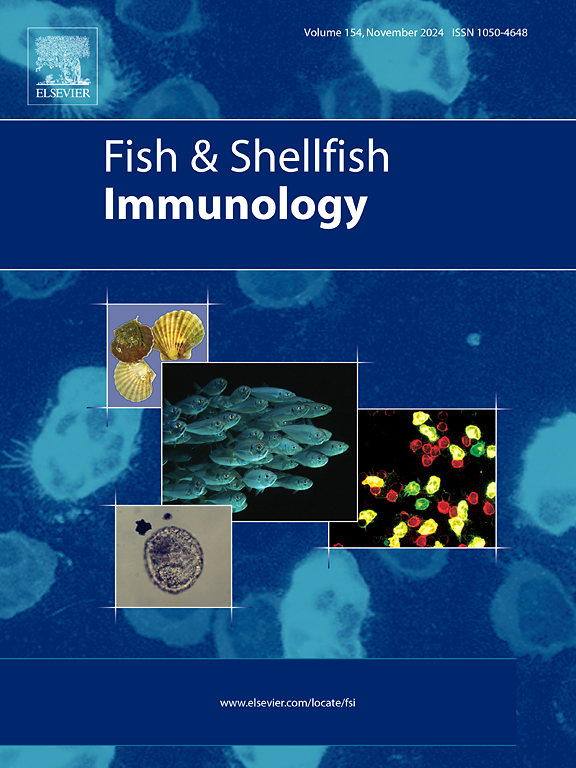鲑鱼唇腺蛋白 3 在鲑鱼白细胞中诱导的细胞死亡:使宿主免疫反应失效的机制。
IF 4.1
2区 农林科学
Q1 FISHERIES
引用次数: 0
摘要
三文鱼虱(Lepeophtheirus salmonis)是一种外寄生虫,以三文鱼的粘液、皮肤和血液为食。被寄生的鱼身上会出现糜烂,到了后期,虱子的取食部位会出现溃疡。对于像大西洋鲑(Salmo salar)这样对虱子排斥有限的易感鱼种,由于鲑虱分泌的蛋白质会抑制免疫反应,因此在这些病变部位只会出现轻微的炎症反应,免疫细胞也会少量涌入。之前的一项研究表明,三文鱼虱唇腺蛋白 3(LsLGP3)可抑制细胞反应,本研究旨在加深我们对其作用模式的了解。研究发现 LsLGP3 会分泌到宿主皮肤上,并进行了体内和体外实验以阐明其功能。对虱子附着部位的组织学分析表明,虱子侵染 5 天后,表皮和真皮中的巨噬细胞和粒细胞大量涌入。在整个虱子侵扰过程中,免疫细胞涌入真皮层的程度更深,LsLGP3可能参与了抑制这种反应。大西洋鲑的 B 细胞、T 细胞、粒细胞和单核细胞在体外暴露于重组 LsLGP3(recLGP3)后,细胞活力比未暴露的对照组显著下降。暴露于 recLGP3 后,所有白细胞组分中都出现了类似 "串珠状 "突起的细胞凋亡形态,但红细胞或角膜细胞中没有出现这种形态。在粉鲑白细胞中还检测到活力下降,而在非鲑鱼物种的白细胞中则没有发现这种现象。这些功能性研究结果表明,LsLGP3 能特异性地诱导鲑鱼白细胞凋亡,而且很可能是一种由虱子分泌的关键蛋白,它能使大西洋鲑鱼无法对鲑虱做出适当的免疫反应。体内 LsLGP3 基因敲除研究表明,这种影响主要集中在虱子的摄食部位,而不会影响不在虱子感染病灶附近的免疫细胞。这项研究的结果将大大有助于开发基于免疫的新型抗鲑虱预防措施和治疗方法。本文章由计算机程序翻译,如有差异,请以英文原文为准。
Cell death induced by Lepeophtheirus salmonis labial gland protein 3 in salmonid fish leukocytes: A mechanism for disabling host immune responses
The salmon louse (Lepeophtheirus salmonis) is an ectoparasite feeding on mucus, skin, and blood of salmonids. On parasitised fish erosions and, at later lice stages, ulcerations appear at the louse feeding site. In susceptible species like Atlantic salmon (Salmo salar) with a limited rejection of lice, only a mild inflammatory response with minor influx of immune cells is seen at these lesions, as the salmon louse secrete proteins that can dampen immune responses. In a previous study, Lepeophtheirus salmonis labial gland protein 3 (LsLGP3) was suggested to dampen cellular responses, and the present study aimed at increasing our understanding of its mode of action. LsLGP3 was found to be secreted on to the host skin, and both in vivo and in vitro experiments were performed to elucidate its function. Histological analysis of the louse attachment site revealed an epidermal and dermal influx of mainly macrophages and granulocytes after 5 days post infestation. The immune cell influx was deeper in the dermis throughout the louse infestation, and LsLGP3 may be involved in dampening this response. Enriched populations of Atlantic salmon B-cells, T-cells, granulocytes, and monocytes were exposed to recombinant LsLGP3 (recLGP3) in vitro, resulting in a significant decrease in cell viability compared to non-exposed controls. An apoptotic cell morphology with “beads-on-a-string” like protrusions was seen in all leukocyte cell fractions after recLGP3 exposure, but not in erythrocytes or keratocytes. A decreased viability was also detected in pink salmon leucocytes, which was not in leucocytes from non-salmonid species. These functional insights suggest that LsLGP3 specifically induces apoptosis of salmonid leukocytes and is likely a key protein secreted by the lice that disables the Atlantic salmon ability to mount an adequate immune response towards the salmon louse. In vivo LsLGP3 knock down studies indicated that the effect is localised primarily at the lice feeding site, without affecting immune cells that are not situated adjacent to the lice-inflicted lesion. The findings from this study could significantly aid in the development of new immune based anti-salmon louse prophylactic measures and treatments.
求助全文
通过发布文献求助,成功后即可免费获取论文全文。
去求助
来源期刊

Fish & shellfish immunology
农林科学-海洋与淡水生物学
CiteScore
7.50
自引率
19.10%
发文量
750
审稿时长
68 days
期刊介绍:
Fish and Shellfish Immunology rapidly publishes high-quality, peer-refereed contributions in the expanding fields of fish and shellfish immunology. It presents studies on the basic mechanisms of both the specific and non-specific defense systems, the cells, tissues, and humoral factors involved, their dependence on environmental and intrinsic factors, response to pathogens, response to vaccination, and applied studies on the development of specific vaccines for use in the aquaculture industry.
 求助内容:
求助内容: 应助结果提醒方式:
应助结果提醒方式:


